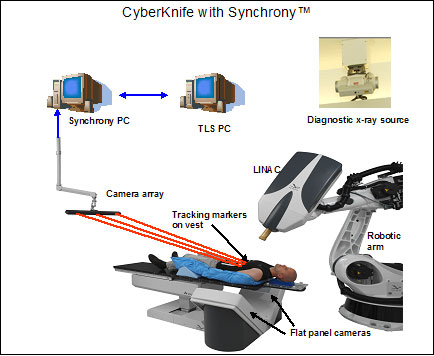Lay-Language Paper
Tracking Moving Tumors with the CyberKnife®
Cihat Ozhasoglu, Ph.D. (ozhasogluc@upmc.edu)
Assistant Professor
University of Pittsburgh Medical Center - Shadyside Hospital
Department of Radiation Oncology
5230 Centre Avenue
Pittsburgh, PA 15232
Tel: 412-623-6317
Fax: 412-291-1266
email: ozhasogluc@upmc.edu
Author Description of Paper WE-D-VaIA-4
Wednesday, August 2, 2006, 2:20 PM
2006 AAPM Annual Meeting, Orlando, FL
The CyberKnife is a radiation delivery system that consists of a linear accelerator radiation source mounted on a robotic arm. The robot arm allows the linear accelerator to deliver multiple (typically 100-150) highly focused beams of radiation that converge at the tumor site.
This aggressive treatment with focused radiation has been very effective in treating brain tumors in the past. Whenever a high dose of radiation is delivered, it is essential that radiation device has a targeting accuracy of less than a few millimeters. This ensures that most of the radiation is received by the tumor sparing other nearby critical organs that may be radiosensitive (i.e. having low tolerance for radiation) and thus can be easily damaged by high doses of radiation. Accomplishing a high degree of targeting accuracy and delivery of focused radiation has been possible with brain tumors because these tumors maintain a fixed position relative to the cranium and a frame, attached to the cranium, is used as a reference frame to accurately localize the tumor.
However, tumors in the thorax and abdomen can move as much as 4 cm during respiration. In order to deliver high dose of radiation with high targeting accuracy, it is essential that the tumor position is tracked in real time. CyberKnife uses real-time diagnostic x-ray imaging in conjunction with external markers attached to patient’s chest or abdomen to track tumors in real time with a few millimeters of accuracy. CyberKnife accomplishes a high level of targeting accuracy for moving tumors by instructing the robotic arm to move the radiation source in sync with the tumor motion. Consequently, the radiation beam always remains aligned with the tumor thus sparing other radiosensitive organs nearby. In effect, CyberKnife robot “chases” the tumor as it moves due to respiration. CyberKnife is the only system available today which can actively track and treat tumors in real-time with a high level of accuracy, which is required when a high dose of radiation is to be delivered.

Main components of the CyberKnife with Synchrony are: (1) Linear Accelerator (LINAC) mounted on robotic arm; (2) Two flat panel cameras positioned perpendicular to diagnostic x-ray sources mounted to ceiling; (3) Synchrony-tracking vest with LED markers attached; (4) Camera array which holds three CCD cameras; (5) Synchrony and Target Locating Computers. (Image used with permission from Accuray Incorporated.)
At the University of Pittsburgh Medical Center and the University of Pittsburgh Cancer Institute, we have established one of the largest CyberKnife teams in the country with approximately 30 specialists including medical physicists, radiation oncologists, radiologists and many surgeons from several disciplines who work in close collaboration. As a result of the unique real-time tumor tracking capabilities of the CyberKnife, even with tumors that move due to respiratory motion, we have established protocols for the safe treatment of lung tumors which otherwise couldn’t be treated with high dose of radiation due to lack of sufficient real-time tracking accuracy of other “conventional” radiation therapy machines. We have been impressed by short-term clinical results where in some cases lung tumors were eradicated in 3-4 months following the CyberKnife treatments. Although it is still too early to determine the long-term effectiveness, the short-term clinical results of the CyberKnife treatments of lung tumors are very encouraging.
###